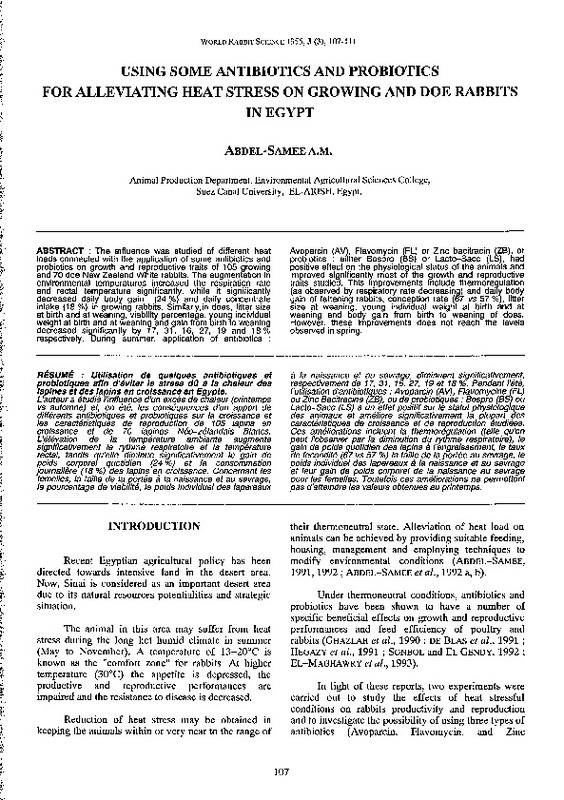JavaScript is disabled for your browser. Some features of this site may not work without it.
Buscar en RiuNet
Listar
Mi cuenta
Estadísticas
Ayuda RiuNet
Admin. UPV
USING SOME ANTIBIOTICS AND PROBIOTICS FOR ALLEVIATING HEAT STRESS ON GROWING AND DOE RABBITS IN EGYPT
Mostrar el registro sencillo del ítem
Ficheros en el ítem
| dc.contributor.author | Abdel-Samee A.M.
|
|
| dc.date.accessioned | 2011-03-21T14:23:16Z | |
| dc.date.available | 2011-03-21T14:23:16Z | |
| dc.date.issued | 1995 | |
| dc.identifier.issn | 1257-5011 | |
| dc.identifier.uri | http://hdl.handle.net/10251/10508 | |
| dc.description.abstract | [EN] The influence was studied of different heat loads connected with the application of sorne antibiotics and probiotics on growth and reproductiva traits of 105 growing and 70 doe New Zealand White rabbits. The augmentation in environmental temperaturas increased the respiration rate and rectal temperatura significantly, while it significantly decreased daily body gain (24 %) and daily concentrate intake (18 %) in growing rabbits. Similarly,in does, litter size at birth and at weaning, viability percentage, young individual weight at birth and at weaning and gain from birth to weaning decreased significantly by 17, 31, 16, 27, 19 and 18% respectively. During summer, application of antibiotics: Avoparcin (AV), Flavomycin (FL) or Zinc bacitracin (ZB), or probiotics : e1ther Bospro (BS) or Lacto-Sacc (LS), had positiva effect on the physiological status of the arnmals and 1mproved significantly most of the growth and reproductiva traits studiea. This 1mprovements mclude thermoregulation (as observad by respiratory rate decreasing) and daíly body gain of fattening rabbits, conception rate (67 vs 57 %), litter size at weaning, young individual weight at birth and at weaning and body gam from birth to weaning of does. However, these improvements does not reach the levels observad in spring. | es_ES |
| dc.description.abstract | [FR] L auteur a étudié l'influence d'un exces de chaleur (printemps vs automne) et, en été, les conséquences d'un apport de différents antibiotiques et probiotiques sur la croissance et les caractéristiques de reproduction de 105 lapins en croissance et de 70 tapines Néo-zélandais Blancs. L'élévation de la température ambiante augmente significativement le rythme respiratoire et la température rectal, tandis qu'elle diminue sig,nificativement le gain de poids corporel quotidien (24 %) et la consommation journaliere (18 %) des lapins en croissance. Concernant les feme/les, la taille de la portée a la naissance et au sevrage, le pourcentage de viabilité, le poids individue/ des lapereaux a la naissance et au sevrage, diminuent significativement, resP.,ectivement de 17, 31, 16, 27, 19 et 18 %. Pendantl'été, l'utilisation d'antibiotiques: Avoparcin (AV), Flavomycine (FL) ou Zinc Bacitracine (ZB), ou de probiotiques : Bospro (BS) ou Lacto-Sacc (LS) a un effet positif sur le statut physiolog1que des animaux et améliore significativement la plupart des caractéristiques de croissance et de reproduction étudiées. Ces améliorations incluent la thermoregulation (te/le qu'on peut f'observer par la diminution du rythme respiratoire), le gain de poids quotidien des lapins a f'engraissement, le taux de fécondité (67 vs 57 %) la taille de la portée au sevrage, le poids individue/ des lapereaux a la naissance et au sevrage et leur gain de poids corporel de la naissance au sevrage pour les feme/les. Toutefois ces améliorations ne permettent pas d'atteindre les valeurs obtenues au printemps. | |
| dc.language | Inglés | es_ES |
| dc.publisher | World Rabbit Science. ICTA. UPV | es_ES |
| dc.relation.ispartof | World Rabbit Science | |
| dc.rights | Reserva de todos los derechos | es_ES |
| dc.title | USING SOME ANTIBIOTICS AND PROBIOTICS FOR ALLEVIATING HEAT STRESS ON GROWING AND DOE RABBITS IN EGYPT | es_ES |
| dc.type | Artículo | es_ES |
| dc.date.updated | 2011-03-21T14:00:42Z | |
| dc.identifier.doi | 10.4995/wrs.1995.248 | |
| dc.rights.accessRights | Abierto | es_ES |
| dc.description.bibliographicCitation | Abdel-Samee A.M. (1995). USING SOME ANTIBIOTICS AND PROBIOTICS FOR ALLEVIATING HEAT STRESS ON GROWING AND DOE RABBITS IN EGYPT. World Rabbit Science. 3(3). https://doi.org/10.4995/wrs.1995.248 | es_ES |
| dc.description.accrualMethod | SWORD | es_ES |
| dc.relation.publisherversion | https://doi.org/10.4995/wrs.1995.248 | |
| dc.description.volume | 3 | |
| dc.description.issue | 3 | |
| dc.identifier.eissn | 1989-8886 | es_ES |








